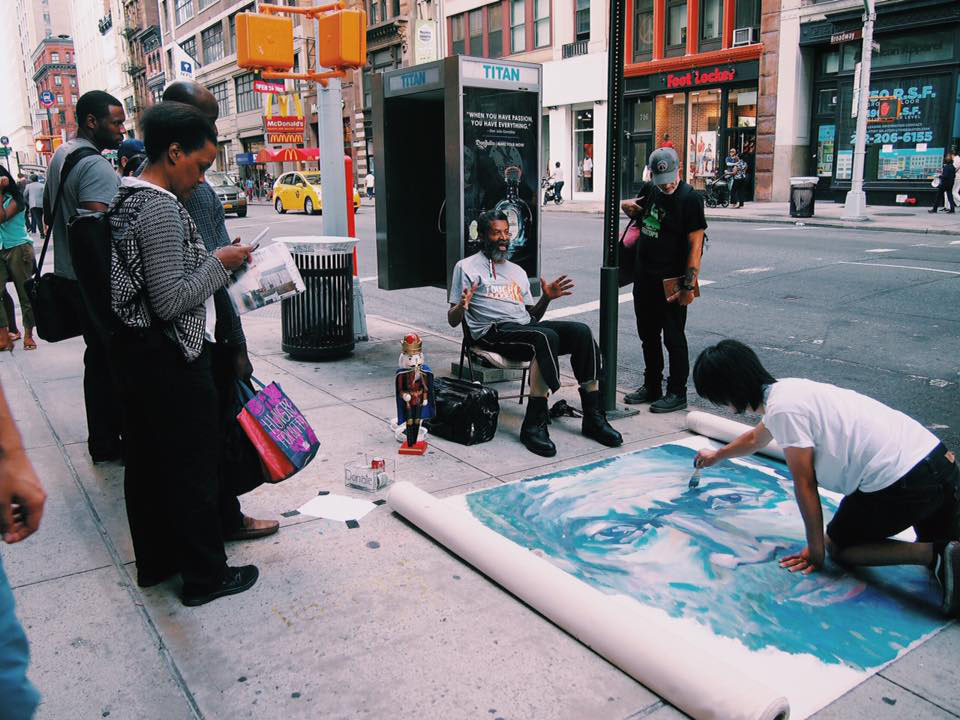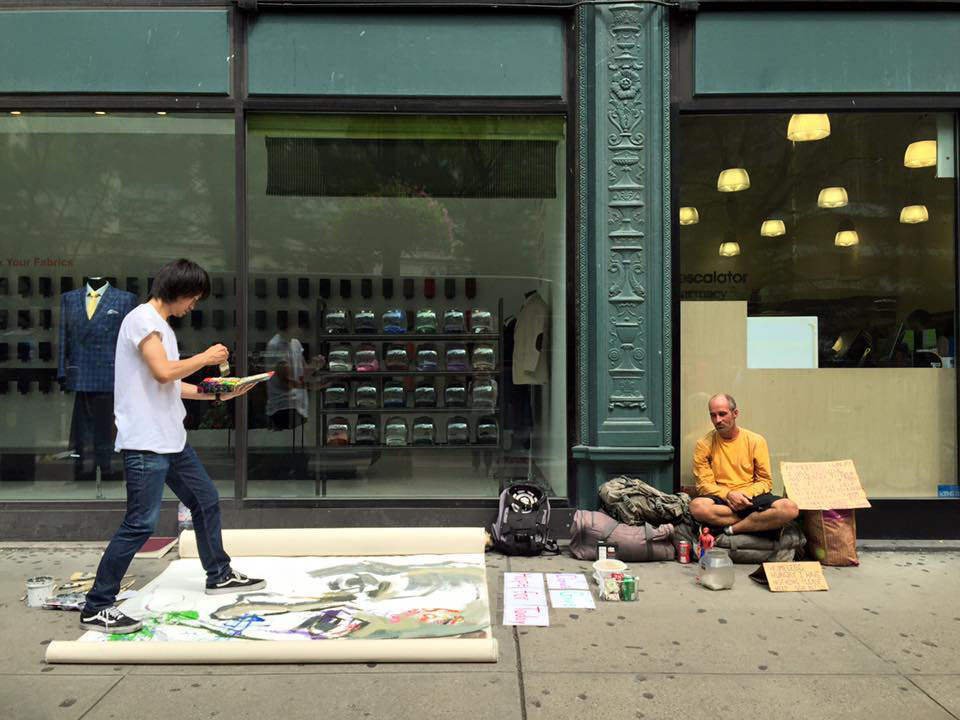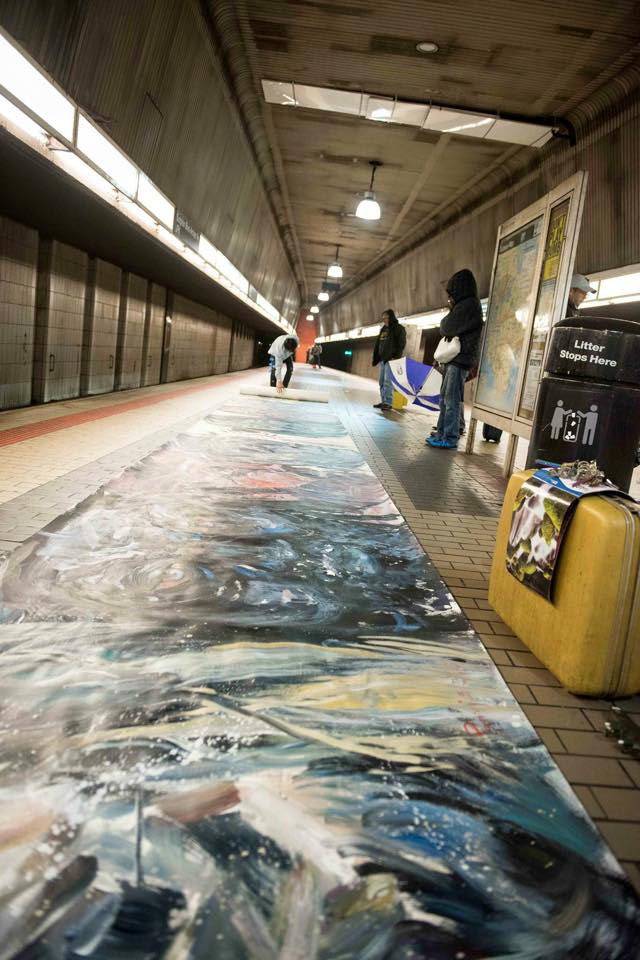Walking home from the Academy of Arts University in San Francisco on a cold autumn night in 2013, Pairoj Pichetmetakul passed a scene he’ll never forget.
On a nearly empty street in the SoMa district, Pairoj saw a young man beating a white-haired homeless man who appeared to be in his 70s. The attacker punched and kicked his victim, then sat on his chest and pummeled his face.
Pairoj wanted to help but fear held him back. He was new in the country, his English was poor, and he couldn’t call the police because his cell phone battery had died. So, he just walked home.
“I couldn’t sleep,” recalled the now-32-year-old artist, who goes by his first name. “I went back in the morning to find the old man but he wasn’t there.”
Three years earlier, Pairoj had been a saffron-robed monk living at the Wat Hua Krabue Buddhist temple near Bangkok, where he recalls trying to avoid stepping on insects while walking between his living quarters and the temple.
Why, then, didn’t he help the homeless man?

That question troubled him so deeply that he resolved to make amends the only way he felt he could—through his art. Thus began an artistic and social project he calls “The Positivity Scrolls.”
First in San Francisco, and now in New York, Pairoj wanders the streets every week pushing a folding cart that holds his brushes, paint, and a long roll of canvas. “What is your name?” he gently asks when he encounters a homeless person. “Why are you homeless? Where is your family? What are your dreams?” And, finally, “Can I paint you?”
Some say no. Some shout and curse at him. Many say yes.
RELATED: How Do You Cultivate Compassion in Your Community?
Taking inspiration from Chinese scroll paintings, Pairoj paints his subjects on 10-foot-wide by 150-foot-long rolls of canvas, sliced into shorter, more manageable lengths that are later stitched back together. He’s already filled four scrolls with side-by-side portraits of some 250 homeless men and women and plans to start work on a 300-foot scroll soon.
He hasn’t shown all the artwork publicly. Finding a venue large enough to display the scrolls is a challenge. One gallery recently rejected him for that very reason.
But the completed paintings are secondary to the message. “I want people to learn from me when I paint,” Pairoj says. “I want to inspire them and let them know the homeless need help. I just remind them that we’re all one. We all need hope.”
On a Saturday in October near Union Square, Pairoj met a man named Michael, a 40-year-old epileptic who had spent much of the day sitting cross-legged on the sidewalk waiting for handouts. Pairoj spread his scroll on the ground in front of him then placed a donation box next to the canvas with a sign reading “Hope For Him” with an arrow pointing toward Michael.
Pairoj worked on his feet, standing on the canvas and bending down to paint with thick strokes in a large, colorful, abstract style he describes as “Thai Street Art.”
“A big portrait shows more emotion and impacts more people when they walk past,” Pairoj says of the project.

Michael, who told Pairoj that he liked to draw, sketched the artist on a small pad with colored pencils that the artist gave him. A young girl stopped to watch. Pairoj asked if she wanted to paint. She did. She began painting a flower on the canvas, next to his portrait of Michael. People passing by stopped to chat and take in the unlikely scene: a Thai artist, a homeless man, and a child painting together on a city street.
Pairoj says the collaborative process makes that homeless visible—and approachable.

“Some homeless people just want someone to talk to. People are scared of them. But when I paint, people come and talk to them,” Pairoj says.
People also give money. The donation box filled with $40 during the hour that Pairoj painted Michael. But Pairoj never keeps the money because he doesn’t want to “profit from their lives.” He gives it to his subjects along with a container of food that he gets from The Spicy Shallot, a Thai restaurant in Queens where he works as a waiter.
RELATED: Building the First Holistic Center for Homeless Youth
And if he ever gets to exhibit the full-length scrolls, he wants to donate the money to The Bowery Mission, a nonprofit on Manhattan’s Lower East Side that provides homeless New Yorkers with shelter, food, and medical care. Pairoj volunteers there, and recently showed three non-scroll paintings at a charity exhibition at The New Museum that earned $600 for the mission.
Laurie-Anne Bentley, the Bowery Mission’s director of corporate partnerships and events, said Pairoj is “a very talented artist” with “a kind heart and great compassion for the homeless and poor in New York City.”
“Often, projects purporting to support the homeless, even if well intended, can feel exploitative or self-promotional,” said Keith Schweitzer, the director and cofounder of The Lodge Gallery in Manhattan, which presented an iteration of The Positivity Scrolls earlier this year. “What has impressed me about Pairoj most, apart from his high degree of execution, is his generosity and selflessness. Pairoj is deeply Buddhist and brings a genuine level of nonjudgmental compassion to his work, and this genuineness is reciprocated by the people he engages.”
Pairoj Pichetmetakul from Tricycle on Vimeo.